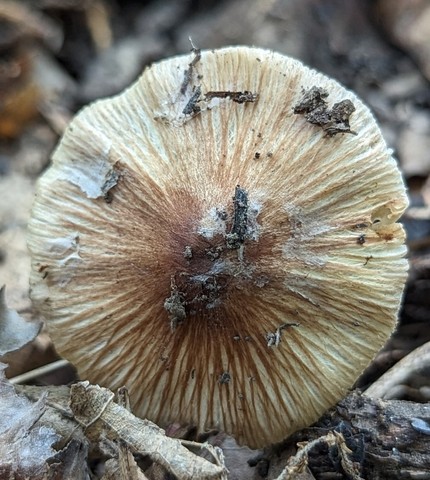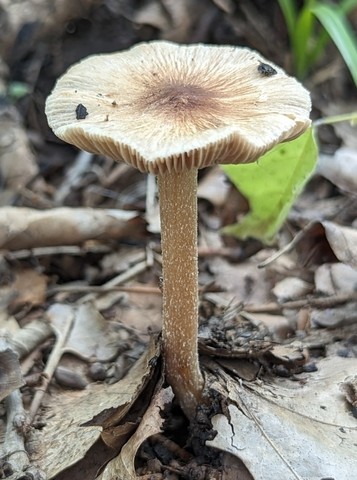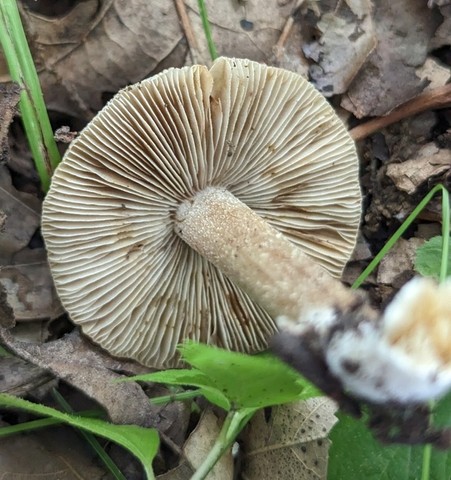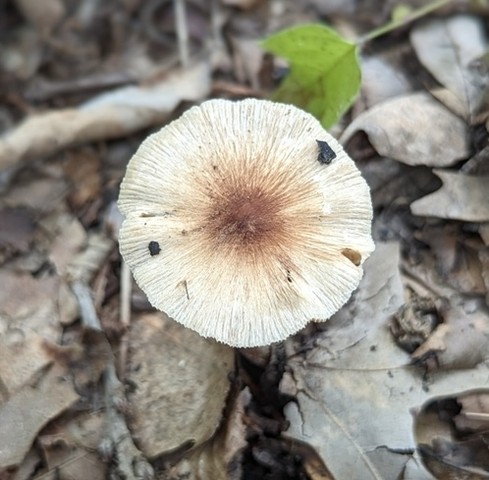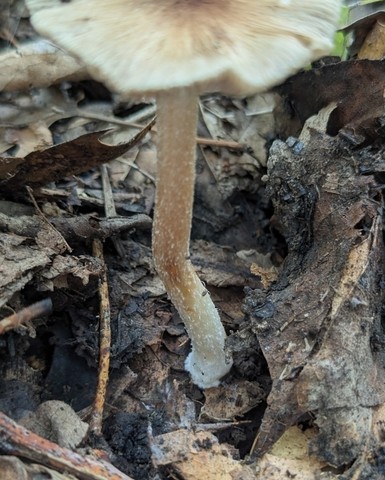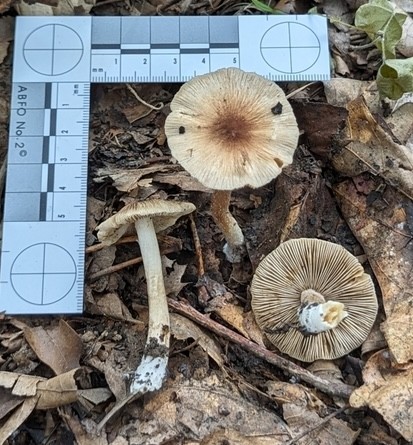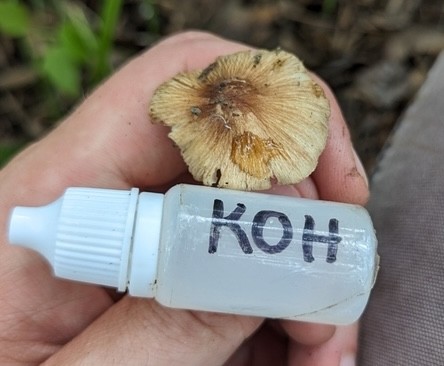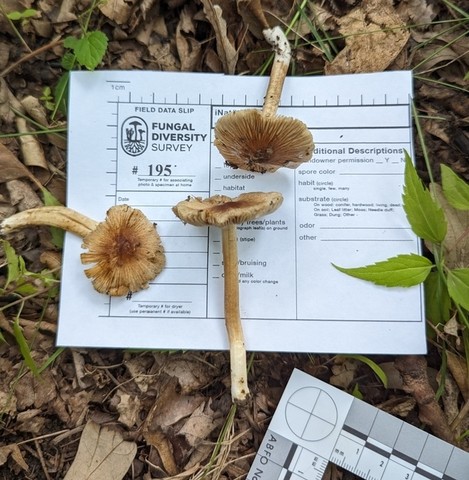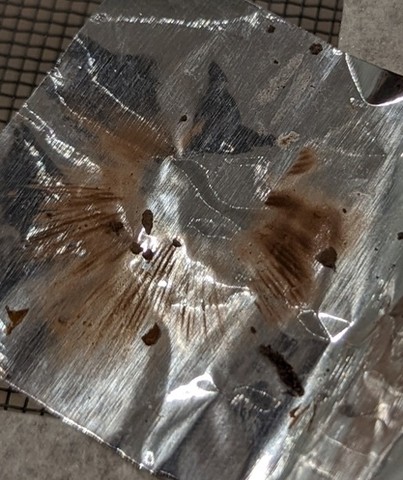Pseudosperma notodryinum
Life > Fungi > Basidiomycota > Agaricomycotina > Agaricomycetes > Agaricomycetidae > Agaricales > Agaricineae > Inocybaceae > Pseudosperma
Description
Pseudosperma notodryinum is a mycorrhizal mushroom that shows up in summer, usually July through August, in mixed forests with pine and oak (Zhang et al., 2022). It grows from the ground and blends in with the leaf litter, often going unnoticed. The cap is dry and yellow-brown to dark brown, with fine cracks or wrinkles across the surface — a feature called rivulose.
Caps start out cone-shaped and flatten with age, reaching about 3/4"-2" (2–4.5 cm) wide. Gills are closely spaced and transition from pale to tan or brownish with age. The stem is long and slender, with a slightly thicker base and a covering of fine white hairs that become fibrous over time. There’s no strong smell, which can separate it from other Inocyboid species. The spore print is brown.
Observations
July 13th, 2023 Indian Cave State Park
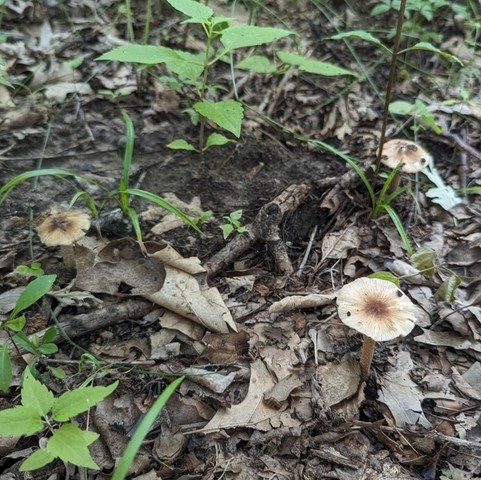
#195
-
Growing gregariously in open mixed oak/hickory woodland edge.
-
Nearby Trees: Black Oak, Bur Oak, Ash, Northern Red Oak, and distant Chinkapin Oak.
-
Lamellae light tan but discoloring yellowish in areas where damaged.
-
White basal mycelium.
-
Smell: Not distinctive.
-
Taste Not distinctive.
-
Spore print: Brown
GTCGTAACAAGGTTTCCGTAGGTGAACCTGCGGAAGGATCATTATTGAATAAACATGATAGGCTGTTGCTGGCTCTTTAGAGGAGCAAGTGCACGCTTGTCAACTTTATTTTATCCACCATGTGCACTGTTTGTAGATTCTAGAGAAACAATTATCTGACTGTTCAGATAGGTTGAGGACTGCTGCGTCTTTCAAAGCCAGCTTTGCCTTCTGTCTCTAGGGTCTATGTCACTCACATACACCTTATGAATGTAATAGAATGTTGACCTGGGTCTTTCAGTACCCATAAAAAGTTTAATATACAACTTTCAGCAACGGATCTCTTGGCTCTCGCATCGATGAAGAACGCAGCGAAATGCGATAAGTAATGTGAATTGCAGAATTCAGTGAATCATCAAATCTTTGAACGCATCTTGCGCTCCTTGGTATTCCGAGGAGCATGCCTGTTTGAGTGTCATCAAATTCTCAACTACAATGATCTCTTCAGTGTAGCTTGGATTTGGGGGACTTTGGCTTTTGTGTATAAAGAAGTCAGCTCCCCTGAAATTGATTAGCGGTACCTTTGTAGACCATCTACAGGTGTGATAATTATCTGCACCCTTAGTTGTCTGAATGCTGCTTCCAGCTTTAACTTGTGACAATCTTGACCTCAAATCAGGTAGGACTACCCGCTGAACTTView MycoMap DNA Results
References
Matheny, P. B., Hobbs, A. M., & Esteve-Raventós, F. (2019). Genera of Inocybaceae: New skin for the old ceremony. Mycologia, 112(1), 83–120. https://doi.org/10.1080/00275514.2019.1668906
Zhang, Z., Liu, J., & Yang, Z. (2022). New species of Mallocybe and Pseudosperma from North China. Journal of Fungi, 8(3), 256. https://doi.org/10.3390/jof8030256
Created December 15, 2025 at 10:41 AM
